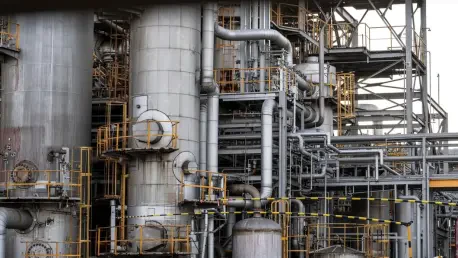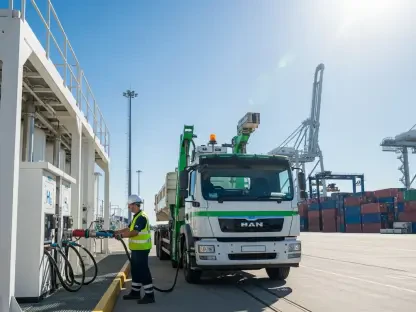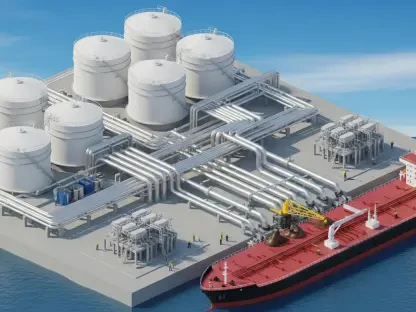South Korea’s petrochemical industry, a vital engine of the nation’s economy, stands on the brink of collapse under the weight of a staggering global oversupply, and with profit margins evaporating and exports plummeting, this sector that once powered industrial growth is now grappling with an existential crisis. How does a country, known as one of the world’s top naphtha importers, navigate a market so flooded that recovery seems years away? This unfolding drama of capacity cuts, government intervention, and corporate survival offers a gripping look into an industry fighting for relevance in a brutally competitive landscape.
The stakes couldn’t be higher for South Korea, where the petrochemical sector underpins countless jobs and contributes significantly to national GDP. As global oversupply—driven largely by massive capacity expansions in China—continues to crush margins, the urgency for reform has reached a tipping point. This story of restructuring isn’t just about numbers or facilities; it’s about the livelihoods of thousands and the future of a cornerstone industry facing challenges that could reshape global trade dynamics. What happens next will define not only the fate of major companies but also South Korea’s standing in the international market.
A Sector Under Siege: Why the Crisis Now?
The petrochemical industry in South Korea is reeling from a perfect storm of overcapacity and shrinking profitability. With global markets saturated, largely due to aggressive production increases elsewhere, local companies are finding it nearly impossible to compete on price or volume. This isn’t a temporary dip; analysts predict that profit margins will remain squeezed until at least 2027, painting a grim picture for a sector that has long been a pillar of economic strength.
Beyond the numbers, the human toll is becoming evident. Factories that once hummed with activity now face the threat of shutdowns, while workers and communities brace for uncertainty. The sharp 11.1% drop in petrochemical exports in the first half of this year alone signals a deeper malaise, forcing stakeholders to confront a reality where inaction is no longer an option. This critical juncture demands bold moves to prevent a total unraveling of an industry integral to South Korea’s identity.
Unpacking the Problem: Overcapacity and Global Forces
At the heart of this crisis lies a fundamental mismatch between supply and demand. Over the past several years, unchecked capacity expansions—especially in China, the world’s largest petrochemical market—have flooded the globe with products, driving down prices to unsustainable levels. South Korea, heavily reliant on naphtha imports to produce chemicals for plastics and other goods, has been hit hard by this oversupply, with no immediate relief in sight.
This global imbalance has exposed vulnerabilities in South Korea’s industrial strategy. Once a leader in petrochemical production, the country now struggles to adapt to a market where competitors churn out volumes at lower costs. The ripple effects extend beyond corporate balance sheets, threatening the stability of supply chains and trade relationships that South Korea has meticulously built over decades. Without drastic intervention, the risk of long-term decline looms large.
Government’s Bold Move: Capacity Cuts and Sweeping Reforms
In response to this mounting crisis, the South Korean government has stepped in with a historic restructuring plan, compelling industry giants to act. Ten major companies, including LG Chem, Lotte Chemical, and Hanwha TotalEnergies, have agreed to slash their naphtha-cracking capacity by 2.7 to 3.7 million metric tons—a cut of up to 25% of the nation’s total capacity of 14.7 million tons. This unprecedented move aims to eliminate excess production and restore competitiveness in a battered market.
Specific actions by companies underscore the scale of this overhaul. Hanwha Solutions, for instance, has already begun shutting down underperforming plants, while DL Chemical is reworking its business model to focus on sustainability. The government, meanwhile, is balancing support with accountability, offering regulatory relief and financial incentives but warning against complacency. The potential impact on global oil markets, given South Korea’s significant naphtha imports, adds another layer of complexity to this high-stakes transformation.
These reforms also carry domestic challenges, as policymakers strive to protect jobs and minimize economic fallout in affected regions. Outdated infrastructure must be phased out, but at what cost to local communities? This delicate balancing act highlights the broader implications of a strategy that seeks not just survival, but a reimagined future for the industry.
Industry Voices: Perspectives on a Tough Road Ahead
Insights from experts and stakeholders reveal the gravity and nuance of this restructuring effort. Hwang Kyu-won, an analyst at Yuanta Securities Korea, emphasizes the government’s pivotal role, noting that linking financial aid to tangible action ensures compliance, especially for debt-laden firms. This perspective underscores the pressure on companies to deliver results rather than rely on handouts.
Chua Sok Peng from LSEG adds a broader view, acknowledging that while restructuring is inevitable, the process will be fraught with difficulties. Meanwhile, Finance Minister Koo Yun-cheol has taken a firm stance, declaring zero tolerance for “free riders” who seek benefits without commitment. Historical parallels, such as the 1999 restructuring of Yeochun NCC Co (YNCC) during the Asian Financial Crisis, offer lessons—yet YNCC’s current financial strain, with looming debt this year, serves as a stark reminder of past challenges resurfacing.
These diverse voices paint a picture of cautious optimism mixed with hard realism. The consensus is clear: tough choices lie ahead, and success hinges on coordinated efforts between government and industry. The path forward, while necessary, remains uncertain for many players caught in this transformative wave.
Charting the Future: Strategies for Industry Survival
For South Korean petrochemical companies, adapting to these mandates requires practical, forward-thinking steps. A shift away from bulk production toward higher-value, specialized products could carve out a competitive edge in a crowded market. Securing sustainable raw material contracts is another critical focus, ensuring cost stability amid volatile global conditions.
Leveraging government incentives, such as tax breaks and eased regulations, offers a lifeline for firms willing to reform. At the same time, balancing capacity reductions with workforce retention is essential to mitigate social and economic disruption. Long-term planning must account for the projected low margins through 2027, pushing companies to innovate and diversify rather than simply scale back.
This transition also demands a cultural shift within the industry, prioritizing resilience over short-term gains. Collaboration across sectors, investment in technology, and a commitment to sustainability could redefine South Korea’s petrochemical landscape. These strategies, while challenging to implement, provide a roadmap for navigating an era of profound change with an eye toward enduring stability.
Reflecting on a Defining Moment
Looking back, the restructuring of South Korea’s petrochemical industry marked a turning point forged in crisis. The government’s decisive intervention, coupled with the industry’s willingness to embrace painful cuts, set a precedent for addressing systemic overcapacity. The echoes of those capacity reductions—up to 25% of total naphtha-cracking potential—reverberated through global markets, underscoring the country’s influence as a key player.
Moving forward, the focus shifted to actionable solutions that could sustain this hard-won progress. Companies were encouraged to deepen investments in high-value products and sustainable practices, ensuring alignment with evolving market demands. Policymakers, too, faced the ongoing task of supporting innovation while safeguarding economic stability in vulnerable regions. This pivotal chapter, though fraught with challenges, opened doors to a reimagined industry poised to adapt and thrive in an unpredictable world.









